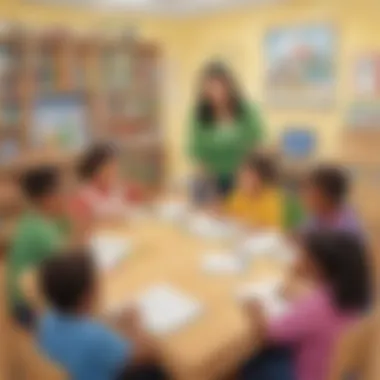Enhancing Classroom Diversity through Culturally Responsive Teaching Strategies


Creative Activities
In the realm of culturally responsive teaching, engaging students through creative activities plays a vital role in fostering inclusivity and understanding. Offering a plethora of craft ideas allows children to express themselves and connect with diverse cultures. These activities serve as a bridge to promoting empathy and appreciation for different backgrounds, enhancing the educational experience. Step-by-step guides accompany each activity, ensuring clear and accessible instructions for implementation. Emphasizing the educational value of these activities, they facilitate experiential learning, cognitive development, and cultural awareness among students.
Fun Quizzes
Integrating fun quizzes into the learning process not only reinforces knowledge but also encourages active engagement with diverse topics. By incorporating a range of quiz topics that reflect various cultures and perspectives, students are exposed to a rich tapestry of knowledge. The inclusion of different question types, such as multiple-choice, true or false, and short answer, caters to diverse learning styles and enhances critical thinking skills. These quizzes serve as a tool for knowledge reinforcement, allowing students to test their understanding and retention of cultural concepts in an interactive and stimulating way.
Fact-Based Articles
Exploring a spectrum of topics through fact-based articles is instrumental in deepening students' understanding of cultural diversity. Presenting information in an engaging and easy-to-understand manner, these articles captivate young minds and spark curiosity about different cultures. Covering a wide array of subjects, from history and traditions to global issues and celebrations, these articles offer a comprehensive overview of the richness and complexity of diverse cultures. Additionally, providing additional resources such as links to related articles or external references further encourages exploration and in-depth learning on cultural phenomena.
Understanding Culturally Responsive Teaching
In this extensive article on Culturally Responsive Teaching, we delve into the vital importance of understanding this concept. Cultural responsiveness in the classroom plays a crucial role in breaking barriers and fostering an inclusive educational environment. By embracing diversity and promoting cultural understanding among students, teachers can create a melting pot of ideas and experiences. This section explores the benefits, challenges, and key considerations related to Culturally Responsive Teaching.
Defining Cultural Responsiveness
The Importance of Cultural Competence
Cultural competence stands out as a cornerstone of Culturally Responsive Teaching. It involves educators being aware of their own cultural background while valuing and respecting the diverse perspectives of their students. By acknowledging the significance of cultural competence, teachers can effectively bridge the gap between different cultural norms and enhance student engagement. This fundamental aspect of understanding enables educators to adapt their teaching methodologies to meet the unique needs of a culturally diverse classroom.
Challenges in Cultural Understanding


Despite its significance, cultural understanding poses certain challenges in educational settings. Educators may face obstacles in fully grasping the cultural nuances of their students, leading to potential misunderstandings and misinterpretations. Overcoming these challenges requires a proactive approach towards building cultural awareness and competence. By addressing these hurdles, teachers can create a more inclusive and supportive learning environment that caters to the diverse needs of all students.
Benefits of Culturally Responsive Teaching
Improved Student Engagement
Enhancing student engagement through culturally responsive practices is a pivotal aspect of modern education. By incorporating students' cultural backgrounds into the curriculum, educators can spark interest and motivation among learners. This approach cultivates a sense of relevance and connection to the material being taught, ultimately leading to higher levels of participation and enthusiasm in the classroom.
Enhanced Academic Achievement
The focus on culturally responsive teaching also correlates with improved academic outcomes. By tailoring teaching methods to align with students' cultural identities, educators can boost academic achievement across diverse student populations. This personalized approach to learning fosters a conducive environment for students to thrive academically and reach their full potential. Embracing culturally responsive strategies can significantly impact students' educational journey and contribute to long-term success.
Creating an Inclusive Classroom Environment
In the realm of education, fostering an inclusive classroom environment holds paramount significance. It serves as a foundational principle in the discourse of culturally responsive teaching. By prioritizing inclusivity, educators acknowledge and embrace the diverse backgrounds, experiences, and perspectives of all students. This approach aims to create a safe and welcoming space where every individual feels valued and respected, contributing to a positive learning atmosphere. Through fostering inclusivity, educators can effectively address the varying needs and strengths of their students, promoting a sense of belonging and equity within the classroom.
Fostering a Sense of Belonging
Building Positive Relationships
Within the domain of fostering a sense of belonging, building positive relationships plays a pivotal role in cultivating a supportive and nurturing classroom environment. Establishing strong connections between students and teachers fosters trust, communication, and mutual respect. Positive relationships empower students to engage actively in the learning process, enhancing their academic performance and overall well-being. The key characteristic of building positive relationships lies in the authentic and empathetic connection between educators and learners. This approach is instrumental in creating a collaborative and inclusive classroom culture, where students feel encouraged to express themselves and seek support when needed.
Promoting Cultural Pride
Promoting cultural pride stands as another essential aspect of fostering a sense of belonging within the classroom. This practice involves celebrating and honoring the diverse cultural backgrounds and identities of students. By acknowledging and valuing each student's heritage, traditions, and beliefs, educators promote a sense of pride and self-worth among learners. Cultural pride reinforces positive self-identity and self-esteem, contributing to students' overall academic success and personal growth. The unique feature of promoting cultural pride lies in its ability to instill confidence and resilience in students, allowing them to navigate challenges and barriers with a strong sense of cultural identity.


Embracing Diversity
Valuing Different Perspectives
Embracing diversity encompasses the acknowledgment and appreciation of different perspectives within the classroom setting. Valuing diverse viewpoints enriches the learning experience by exposing students to varied ideas, beliefs, and experiences. By encouraging an inclusive environment that values different perspectives, educators promote critical thinking, empathy, and understanding among students. The key characteristic of valuing different perspectives lies in fostering a culture of acceptance and open-mindedness, where students feel empowered to share their viewpoints without fear of judgment or bias.
Celebrating Multiculturalism
Celebrating multiculturalism entails recognizing and embracing the multicultural composition of the classroom. This practice involves actively incorporating diverse cultural elements, approaches, and resources into the teaching and learning process. By celebrating multiculturalism, educators create an enriching and inclusive educational environment that reflects the varied identities and experiences of students. The unique feature of celebrating multiculturalism lies in its capacity to create a dynamic and engaging learning environment, where students feel represented, valued, and empowered. This approach fosters cross-cultural understanding, empathy, and cooperation among students, preparing them to thrive in a diverse and interconnected world.
Integrating Culturally Relevant Content
In the realm of culturally responsive teaching, integrating culturally relevant content emerges as a crucial component. This approach involves infusing curriculum with materials and resources that mirror the diversity of students' backgrounds. By incorporating content that reflects students' identities and experiences, educators create a learning environment that fosters inclusivity and understanding. The significance of integrating culturally relevant content cannot be overstated, as it directly contributes to students' engagement and academic success. Furthermore, this strategy aids in bridging cultural gaps within the classroom, promoting respect and appreciation for diverse perspectives.
Incorporating Diverse Perspectives
Using Multicultural Literature
Delving deeper into the concept of integrating culturally relevant content, using multicultural literature stands out as a pivotal method. This involves incorporating literary works from various cultures and ethnicities into the curriculum. The utilization of multicultural literature allows students to explore different worldviews, traditions, and histories, enriching their knowledge and empathy. By interacting with characters and narratives that resonate with their backgrounds, students can feel represented and valued in the educational setting. Additionally, multicultural literature exposes learners to new ideas and perspectives, sparking critical thinking and cultural awareness.
Exploring Global Perspectives
Another aspect of integrating culturally relevant content is through the exploration of global perspectives. By incorporating materials that showcase diverse global viewpoints, educators expand students' horizons beyond their immediate surroundings. This broadens students' understanding of different cultures, societies, and global interconnectedness. Exploring global perspectives in the curriculum provides students with a more comprehensive worldview, promoting tolerance and curiosity about the world at large. Moreover, it cultivates a sense of unity among learners, emphasizing the shared human experience despite cultural differences.


Addressing Social Justice Issues
Teaching Historical Context
Within the domain of culturally responsive teaching, addressing social justice issues through teaching historical context plays a vital role. This aspect involves contextualizing historical events within their social, cultural, and political frameworks. By examining history through a critical lens, students gain a deeper understanding of the complexities surrounding social injustices and inequalities. Teaching historical context enables students to reflect on past struggles and triumphs, fostering empathy and a sense of civic responsibility. Additionally, it empowers learners to advocate for a more equitable and inclusive society.
Promoting Equity and Inclusion
Promoting equity and inclusion represents a fundamental pillar of culturally responsive teaching. This aspect revolves around creating a classroom environment where every student feels affirmed and respected. By promoting equitable practices and inclusive policies, educators ensure that all students have equal access to resources and opportunities. Emphasizing equity and inclusion in the curriculum fosters a sense of belonging and acceptance among students from diverse backgrounds. It also reinforces the values of social justice and fairness, preparing students to become empathetic and socially conscious individuals.
Promoting Cross-Cultural Communication
Building Cultural Awareness
Encouraging Dialogue
Delving into Encouraging Dialogue within the realm of Culturally Responsive Teaching accentuates the significance of open communication channels that facilitate understanding and empathy. Encouraging Dialogue allows students to express their perspectives, fostering a collaborative learning environment where diverse voices are heard. Its essence lies in promoting active listening and constructive exchanges, leading to deeper cultural awareness and mutual respect. This aspect serves as a cornerstone in enhancing students' comprehension of different cultural viewpoints, nurturing empathy and cultural sensitivity within the classroom.
Respecting Different Communication Styles
Respecting Different Communication Styles is instrumental in acknowledging the varied ways in which individuals express themselves across different cultural contexts. By recognizing and valuing these diverse communication styles, educators can create an environment that honors individuality and cultural uniqueness. This approach acknowledges that communication is not monolithic but rather nuanced and multifaceted, enriching interactions and fostering mutual understanding. While Respecting Different Communication Styles opens avenues for cultural exchange and appreciation, it also poses challenges related to effective interpretation and comprehension. Despite its complexities, embracing diverse communication styles contributes significantly to cultivating a culturally responsive classroom dynamic.
Engaging with Parents and Communities
Cultivating Partnerships
The concept of Cultivating Partnerships underscores the collaboration between educators, parents, and communities to support students' academic growth and holistic development. By fostering strong partnerships, schools can enhance cultural understanding and inclusivity, creating a unified support system for students. Cultivating Partnerships involves open communication, mutual respect, and shared goals to ensure that students receive comprehensive support both in and out of the classroom. This collaborative approach strengthens the relationship between school and home, encouraging parental involvement and community engagement in promoting cultural diversity and educational equity.
Involving Community Resources
Involving Community Resources emphasizes the integration of external support systems and resources from the community to enrich students' learning experiences. By tapping into community assets such as cultural organizations, local institutions, and community experts, educators can provide students with diverse perspectives and real-world connections. Involving Community Resources not only supplements classroom learning but also immerses students in authentic cultural contexts, fostering a deeper understanding of societal dynamics and multicultural values. While leveraging community resources enhances educational relevance and engagement, logistical challenges and resource limitations may present obstacles in effectively integrating these external factors into the curricular framework of Culturally Responsive Teaching.







